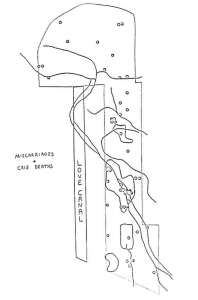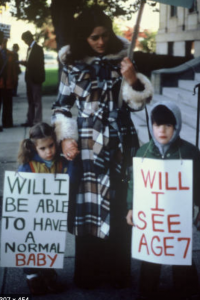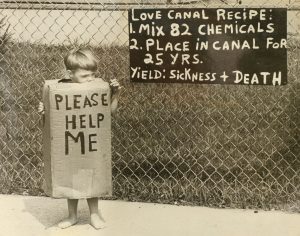Chemical Mishaps leads to Miscarriages

The toxic waste from the chemical dumping site uniquely affected the women residing in Love Canal. The rate of miscarriages increased by 300%. Figure 1.0 is a map drawn by Dr. Beverly Paigen indicating the cases of miscarriages and crib deaths up until 1979. Dr. Paigen served on an Environmental Protection Agency group known as the Carcinogen Assessment Group. She was conducting research to determine the correlation between miscarriages and chemical waste exposure. She found that “women living closer to the waste site had an increased 25% chance of having a miscarriage” (Department of Health, n.d.). The small circles on the map signify the households that had miscarriages and crib deaths as of 1979. Even though the map shows approximately 40 cases of miscarriages this number is relatively high given Love Canal is a small town. The cases of miscarriages were continuing to increase. In the late 1970s, Governor Hugh Carey urged pregnant women and children to relocate from Love Canal as soon as possible. Families who were not able to relocate were temporarily housed in the Niagara Falls Hotel and the Niagara Falls University. The Department of Health conducted research that confirmed: “women living in southern section show the highest risk for miscarriages and birth defects” (Gibbs, 2008). Children were born with three ears, deafness, cleft palates, three rows of teeth, a missing and deformed kidney, immature lungs, webbed feet, etc (Department of Health, n.d.). (The chemical waste has caused generational damage and has affected these kids’ lives from the day they were born. Pregnant women were exposed to these chemicals, ultimately risking their well-being and their child’s health. Organizations such as the Love Canal Home Owners were crucial for these working-class families who needed to leave Love Canal for the health of their family but could not afford to permanently relocate.
Classrooms and Carcinogens
In 1953, the city of Love Canal purchased the sixteen-acre waste site covered with cement from the Hooker Chemical Company for 
 $1.00 to build a new school for the growing population. The city proceeded to build the 99th Street school above the 21,800 tons of chemicals. The 1977-78 school year reported a total of 410 students enrolled at the school elementary school (Department of Health, n.d.). These students were being contaminated as they were attending class. There were a total of 82 different chemicals, 11 of which were carcinogens. Many mothers reported an increase in nervous breakdowns, hyperactivity, epilepsy, and urinary tract disorders among their elementary-aged school children. The city’s decisions to build a school above a toxic waste site may have only cost them a dollar upfront, but it was not a good deal given the countless health risks that have arisen among these young children due to chemical waste exposure. These health risks will live on with the children and continue to be passed down generationally.
$1.00 to build a new school for the growing population. The city proceeded to build the 99th Street school above the 21,800 tons of chemicals. The 1977-78 school year reported a total of 410 students enrolled at the school elementary school (Department of Health, n.d.). These students were being contaminated as they were attending class. There were a total of 82 different chemicals, 11 of which were carcinogens. Many mothers reported an increase in nervous breakdowns, hyperactivity, epilepsy, and urinary tract disorders among their elementary-aged school children. The city’s decisions to build a school above a toxic waste site may have only cost them a dollar upfront, but it was not a good deal given the countless health risks that have arisen among these young children due to chemical waste exposure. These health risks will live on with the children and continue to be passed down generationally.
Repopulated by the Poor
In the early 1990s, the state began to sell the homes in Love Canal that they initially purchased in order for people to reinhabit the empty homes. Many people “already put down $100 deposits on houses” before the state could “guarantee their safety in writing” The houses were placed on sale for below-market prices, which attracted more low-income people to Love Canal. The 21,800 tons of chemicals remained buried under the canal, yet the area was deemed fit for rehabilitation by the state. The state wanted to earn back the money they lost from the home buyout in the 1970s. These homes were sold for as little as 40,000-60,000. The lack of safety guarantees did not deter people from buying these homes because they do not have the means to live elsewhere. Even though living by the canal poses severe health risks, some people had to forgo their safety in order to buy a home for a low price. The new poor population falls back into the health disaster caused by the chemicals buried beneath them (Love Canal Homes Attract Dozens of Potential Buyers 1990).